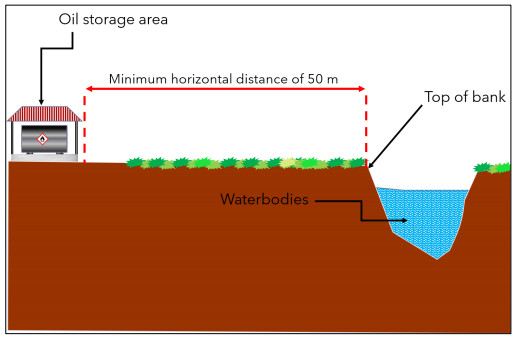HOME / ISOMETRIC MAP / POPULATED AREA / WASTE MANAGEMENT / 9.0 CONTROL OF OIL AND SCHEDULED WASTE & SCHEDULED WASTE MANAGEMENT
9.0 CONTROL OF OIL AND SCHEDULED WASTE & SCHEDULED WASTE MANAGEMENT
9.1 Control of Oil and Scheduled Waste
1. Store oil and fuel in rigid containers and tanks. Label containers and tanks with information on volume, contents, and safety instructions.
2. Construct the storage area with the following specifications:
2.1 Cover the floor of the storage area with concrete or any other suitable lining material, free of cracks and gaps.
2.2 Construct an impervious dike/bund (secondary containment system) to contain spillages. This should enclose a volume, which is at least 110% of the capacity of the largest container.
2.3 Provide a roof for the oil storage area to protect the oil material from sun and rain.
2.4 Provide an oil trap for the storage area.
Figure 14: Typical design of an oil trap.
3. Conduct maintenance for the dike/bund and oil trap at regular intervals. Maintenance dates must be recorded. Dispose oil and grease confined within the bund or oil trap as scheduled waste.
4. Place mobile and non-permanent oil and fuel containers on firm and dry spill trays.
5. Locate oil and fuel storage at a minimum distance of 50 meters away from any watercourse or water body. Refer to Figure 15.
9.2 Scheduled Waste Management
1. Store all scheduled waste (e.g., spent oil and grease) in containers that are durable and able to prevent spillage or leakage into the environment. Label containers clearly in accordance with the Third Schedule of the Environmental Quality Scheduled Wastes Regulations 2005.
2. Refer to SOP 9.1.2 for the construction of the storage area.
3. Locate scheduled waste storage areas at least 50 meters away from any watercourse or water body. Refer to Figure 15.
Figure 15: Illustration showing measurement of the horizontal distance between the oil storage area and the top of the bank.
4. Prohibit the disposal of scheduled waste in drains, ditches, and/or watercourses.
5. The scheduled waste generated on-site, regardless of its volume or quantity, must be collected by a contractor licensed by the Department of Environment.
6. Submit a written application to the Department of Environment (DOE) for re-using scheduled waste on-site when applicable.
7. Submit volume of scheduled waste generated on-site to DOE via the Electronic Scheduled Waste Information System (eSWIS) on a monthly basis. Refer to the eSWIS Hands-on Guideline from the DOE website for instructions on how to use the system.
8. Clean up spilled scheduled waste material when spotted. When materials are spilled on soil, use a shovel or scoop to transfer the contaminated soil into appropriate containers such as metal drums or polyethylene bags, to be eventually disposed as scheduled waste.
9. Refer to guidelines listed in Appendix 1 for additional references on managing scheduled waste.








